Anode Bevel & FS (Week 6)
1/47
There's no tags or description
Looks like no tags are added yet.
Name | Mastery | Learn | Test | Matching | Spaced |
|---|
No study sessions yet.
48 Terms
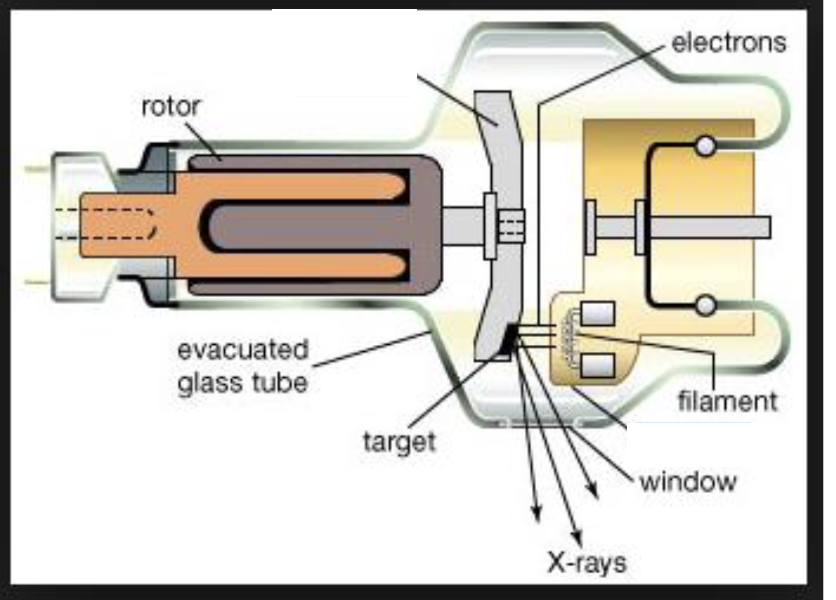
Where is the anode & cathode?
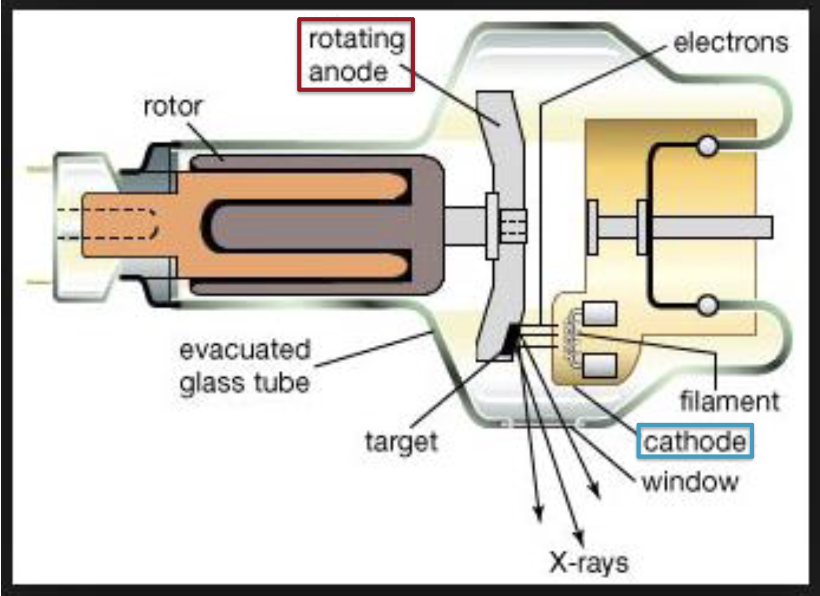
The angle of the anode bevel effects?
The size of the effective focal spot (line-focus principle)
The distribution of the x-ray intensity within the beam (anode heel effect)
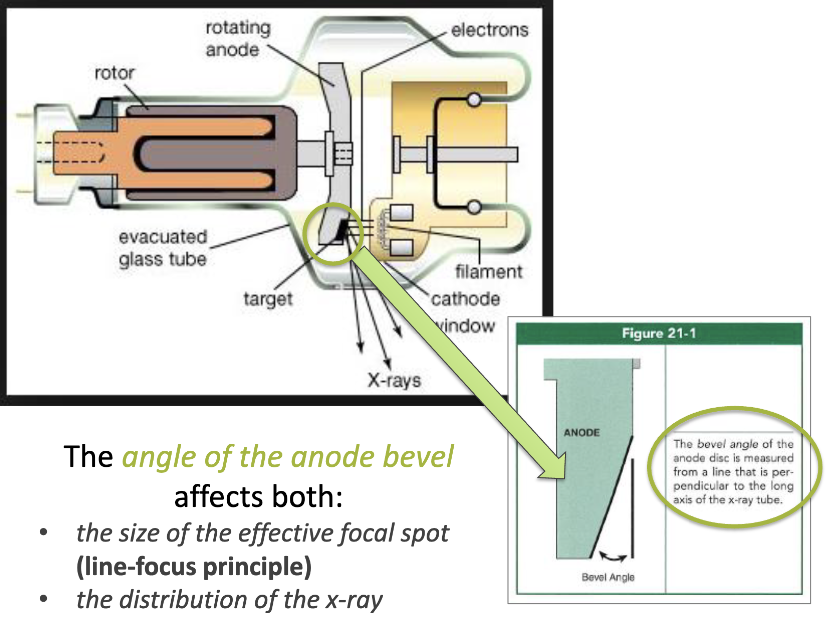
What is the line-focus principle?
The size of the effective FS
What is the anode heel effect?
The distribution of the x-ray intensity within the beam
OR
As we progress across cathode to the anode, the x-rays produced have effectively more & more filtration to pass through just to be emitted from the tube
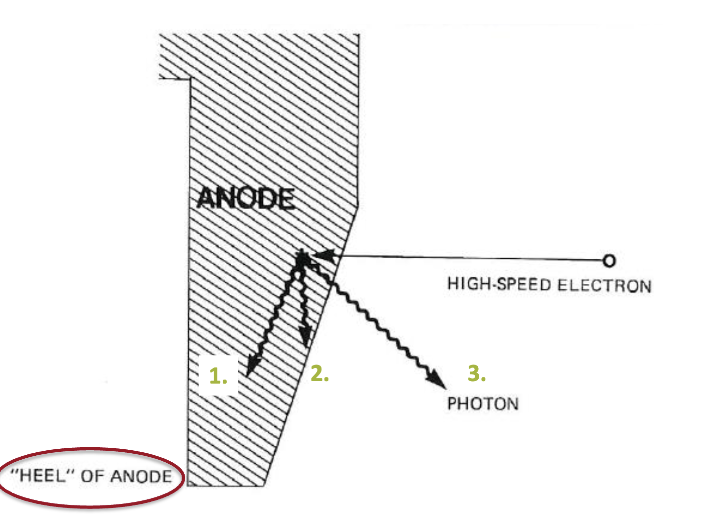
What is the purpose of the line-focus principle?
Reduce the effective FS area
In order to achieve MAXIMUM sharpness while maintaining good heat dispersion
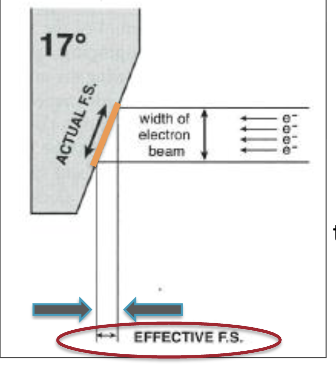
What allows for the best resolution while permitting maximum heat dissipation from the heat generated in the anode from the colliding electrons?
Smaller the effective FS = the greater the sharpness in image
Anode reaches tremendous temperatures during exposure — the entire disc can glow “white hot” like a light bulb
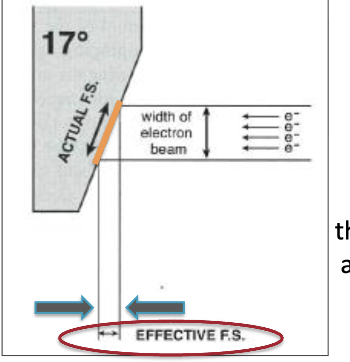
In the line-focus principle, the SIZE of the effective focal spot determines what?
Electron sharpness
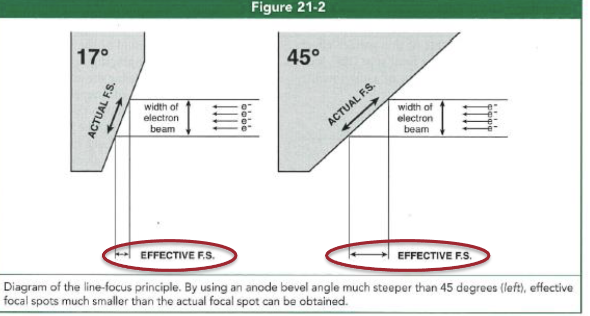
If you have a steeper anode (smaller angle) in the line-focus principle, the size of the effective focal spot will be ___ and the image will be ____ sharp.
smaller, more
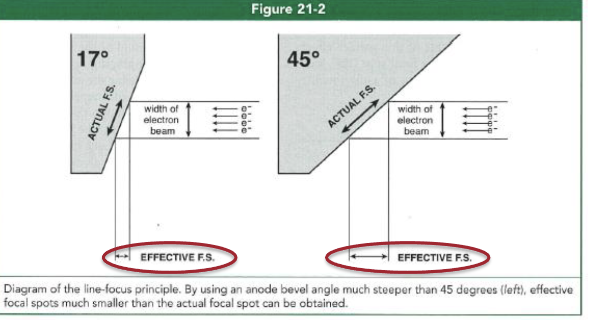
What is size of the effective focal spot controlled by?
Width of the beam of electrons striking the anode
Which is determined by the size of the filament used
Angle of the anode bevel
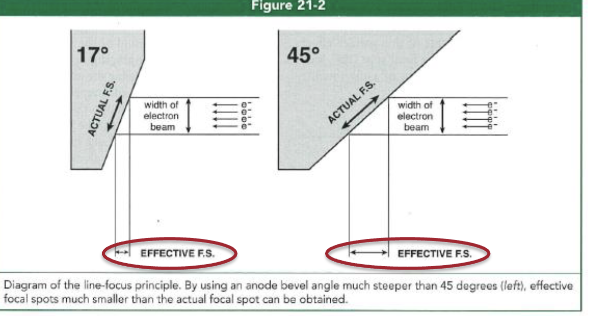
At ____ degrees, the effective FS is the same width as the beam of electrons striking the anode.
45
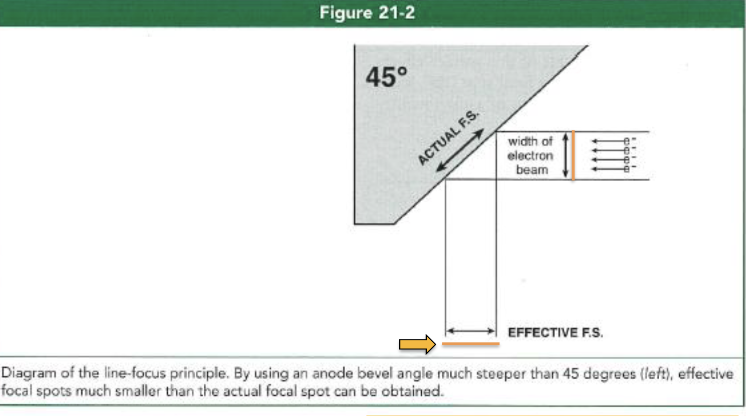
By beveling the anode at a lesser angle of 45 degrees, the target surface is steeper, which causes the effective FS to be projected _____ than the width of the beam of electrons.
smaller
By keeping the actual FS larger, it provides a ____ space to spread the heat over.
bigger
if we decrease the width of the electron beam to the desired size of the effective FS, then we would melt the anode
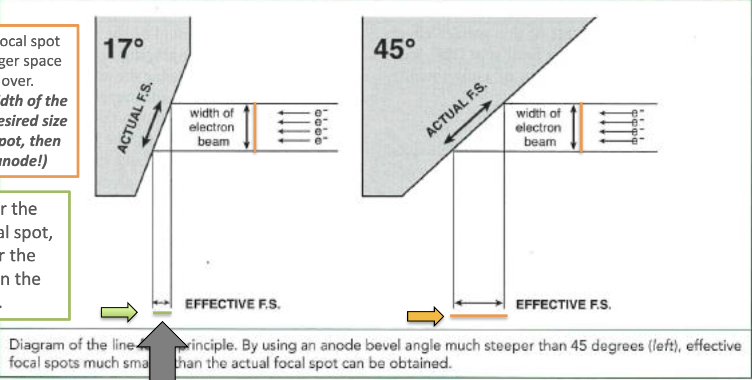
What is the actual FS?
width of electron beam hitting the anode
What is the effective FS?
width of electron beam leaving
Standard diagnostic tubes have anode bevel angles anywhere from _____
12-17”, the book is 15-17”
special procedure tubes (cardiac cath & angiography) can have anode bevels as steep as 7-10 degrees to achieve extra-small effective FS
For a large FS setting, what kind of filament wire would we use?
Larger filament wire selected within focusing cup
wider electron beam striking the anode
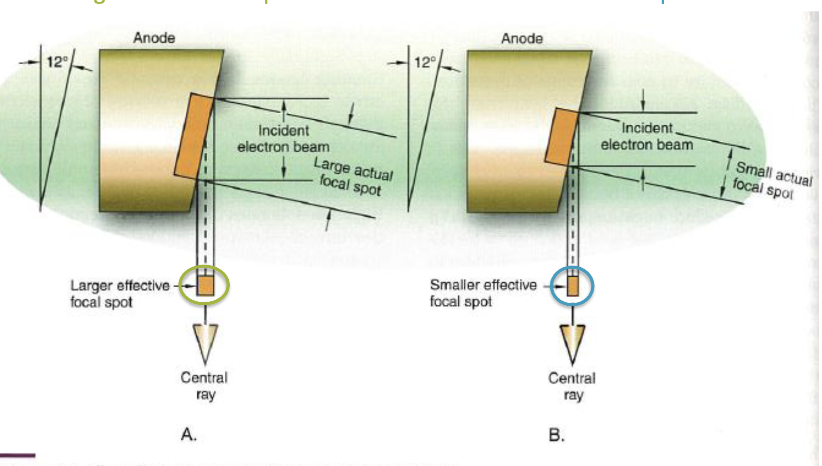
For a large FS setting, what would the effective FS be?
1-2 mm
More heat dissipation for higher techniques… less emphasis on sharpness
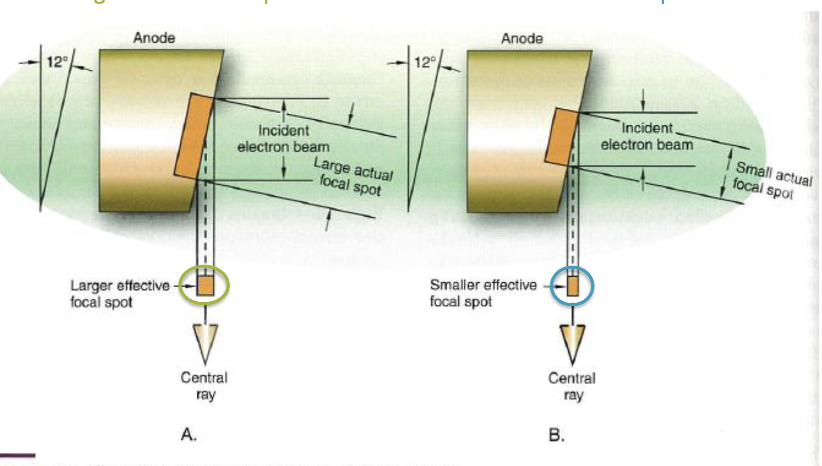
What anatomy would you need a large FS setting for?
Chest, Abdomen, Pelvis
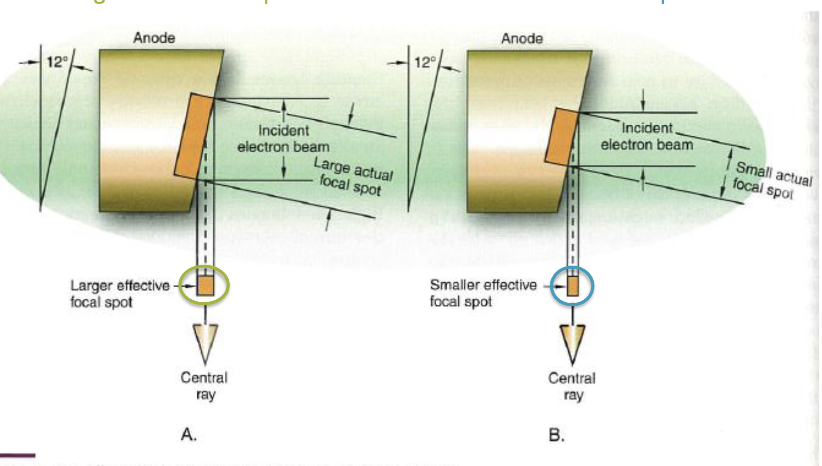
For a small FS setting, what kind of filament wire would we use?
Smaller filament wire selected within focusing cup
thinner electron beam striking the anode
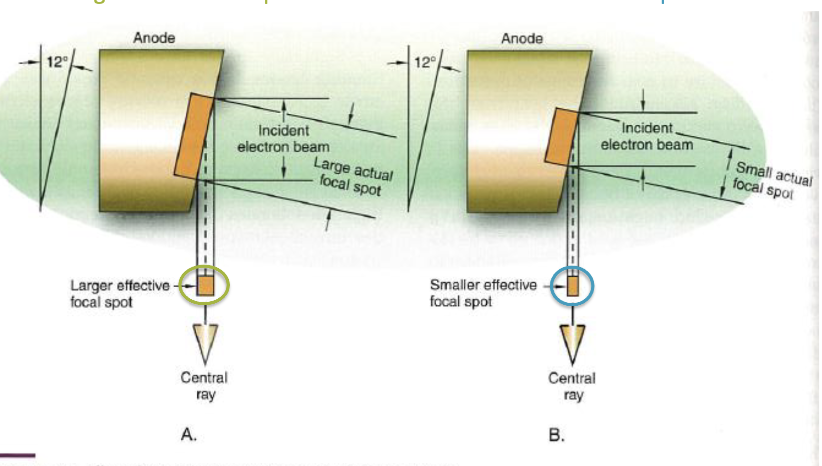
For a small FS setting, what would the effective FS be?
Effective FS size of 0.5-1mm
Increased detail… improved sharpness
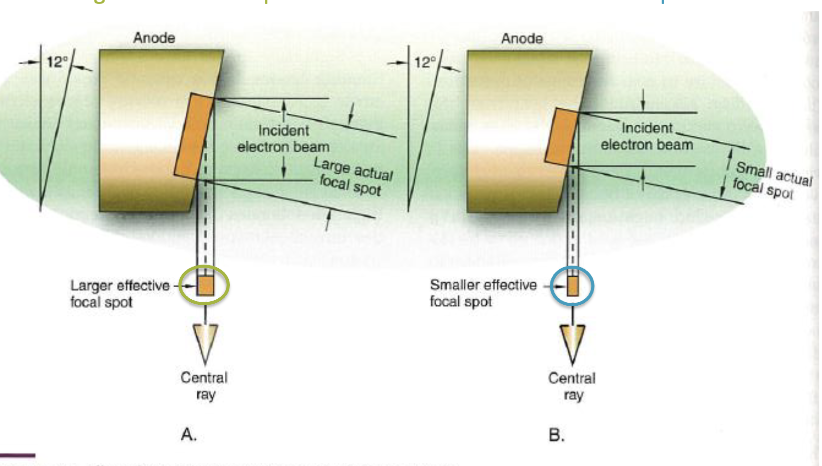
What anatomy would you need a small FS setting for?
Extremities or skull
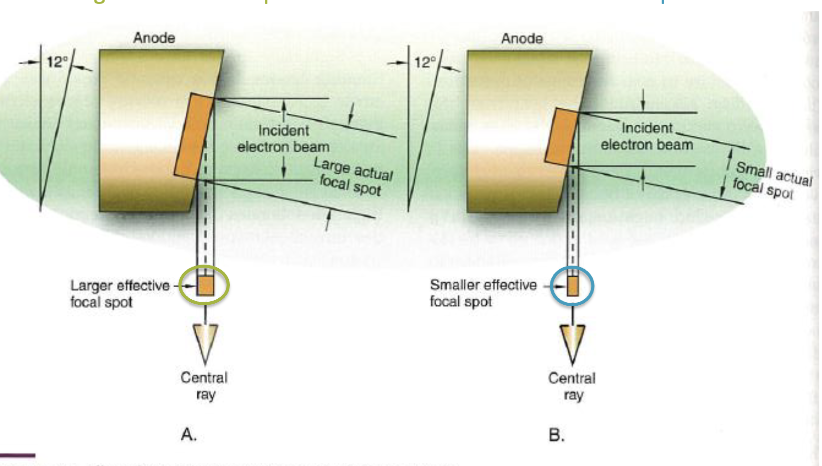
If you increase technique, you increase ______.
heat exposure
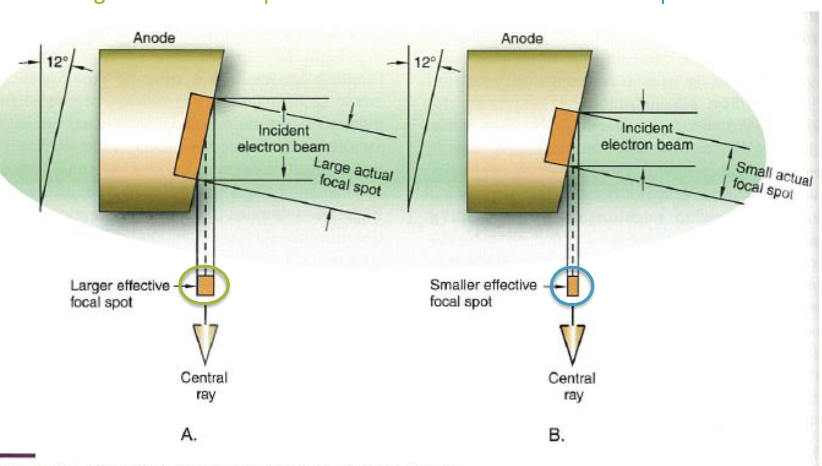
In practice, FS sizes change depending on where it falls on the ___.
IR
At the anode end, the projected FS is _____ than the effective FS.
smaller- because it comes off a sharper angle
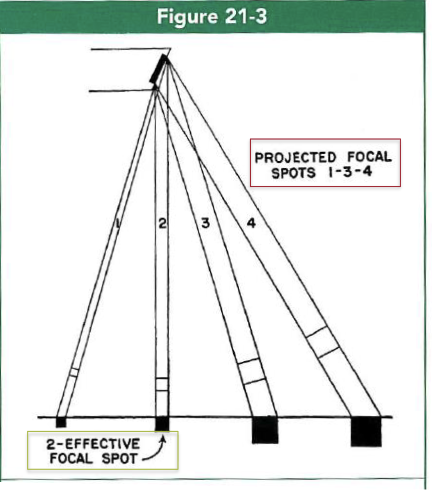
At the cathode end, the projected FS is ____.
larger - because the FS is seen more face-on at this location
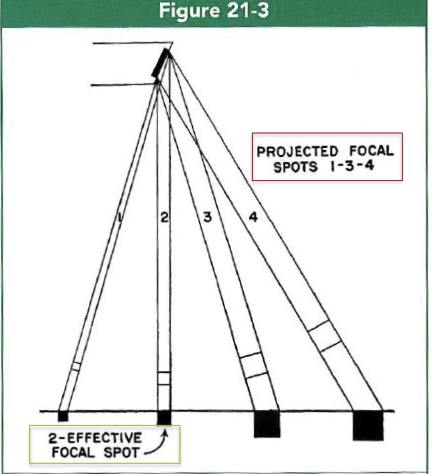
By beveling the anode at a steep angle, the effective FS can be projected at a much smaller size than the _______.
actual FS
Discuss the differences between the actual FS and the effective FS.
Actual: physical area on anode target struck by electrons
Effective: size of the FS as projected toward the pt or IR (it appears smaller due to anode angle)
The actual FS is the area available for the dispersion of ____ generated in the anode from the colliding electrons.
heat
The actual FS is best measured along the…
cathode-anode axis
Rather than using the line-focus principle, why don’t we just focus down the beam of electrons so that the actual FS is 0.5mm?
Because a very small actual FS would cause overheating & damage to the anode (poor heat dispersion)
The projected FS is largest at the end of the ____ IR.
cathode
Because of the line focus principle, the ____ end of the resulting image is actually sharper than the ____ end of the image.
anode, cathode
The anode acts as ____ ______, causing a variation in the x-ray intensity along the longitudinal tube axis.
inherent filtration
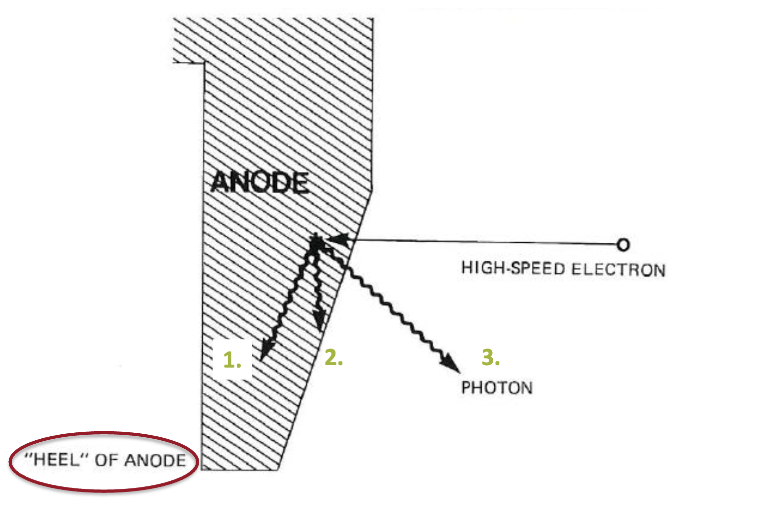
Which arrow will lose the most intensity as it travels out of the tube and which one will have the greatest intensity as it travels out of the tube? Explain.
Least: 1
has farthest to travel through anode, gets filtered (attenuated) the most and loses the most intensity
Most: 3
has the least amount of travel through the anode so it will lose the least amount of intensity
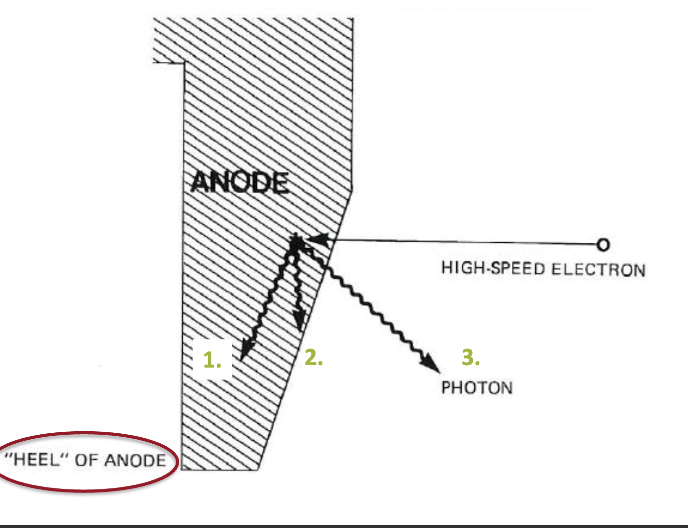
What things amplify the impact of the Anode Heel Effect?
More acute Anode Bevel Angles
causes increased thickness of the heel
Larger FS
difference in anode material thickness is greater from one end of the FS to the other
Shorter SID’s amplify the impact
Larger imaging plates
How to we use the anode heel effect to our advantage?
use it when imaging body parts of differing thickness
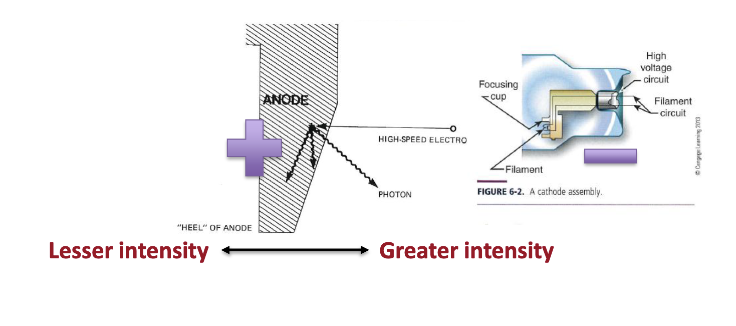
Using the anode heel effect, which end of the tube should we place the knee side of a tib/fib?
Thicker side with calf - greater intensity
Thinner side with toes - lesser intensity
What does the Fat Cat analogy mean?
Place the THICKER anatomy toward the CATHODE end
X-ray tubes are generally installed with the anode to the ____ as the radiographer approaches the table.. but you should look for the +/- symbols printed on the tube for confirmation.
left
At shorter sid, the collimator must be opened to cover the same field size. This causes the anode heel effect to increase or decrease?
Increase
decreasing the SID requires using more of the extreme edges of the x-ray beam, and at these edges, the intensity difference between the anode and cathode sides is much more pronounced.
An increased field size at a shorter SID also exposes more of the low-intensity anode end and high-intensity cathode end of the beam.
The smaller the focal spot = ____ sharpness
increased
The smaller the FS = the _____ penumbra
smaller (decrease)
As the penumbra grows with a larger FS, it spreads _____ as well as invading the ___________.
inward
pure umbral shadow/umbra
What is equation for penumbra?
FSxOID/SOD
(These are the ONLY 3 details that control sharpness of details in the image)
Why does FS not affect magnification?
Umbra hasn’t increased in size; penumbra is invading, which makes the umbra decrease in size
The increase in size would need to be in both axes
What controls magnification?
Our distances (SID, SOD, OID)
M = SID/SOD
specifically OID
if we increase SOD, the OID decreases by default
SID - SOD = OID
What does FS NOT affect?
2/3 of the geometric factors
size distortion
shape distortion
Visibility factors
contrast
brightness
noise
FS only affects ____, so therefore it is the primary controlling factor.
Sharpness